“Prisoners did not have any rights”, Witness Him Huy Says
Today, May 4, 2016, witness Him Huy continued his testimony. He gave evidence regarding the treatment of children at S-21, study sessions, authority structures, the interrogation and executions of Vietnamese soldiers at S-21, and gave detailed description of the procedure of executions at Choeung Ek.
Study sessions – prisoners had to be executed
All parties were present, with Nuon Chea following the hearing from the holding cell.
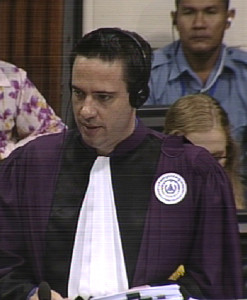
International Senior Assistant Prosecutor Travis Farr
Senior Assistant Prosecutor Travis Farr opened his line of questioning by inquiring whether Mr. Him Huy attended political study sessions, and if so, who held them and what was discussed. He replied that they had to be “absolute” towards their enemies and that they had to acknowledge that people who were arrested by the Party were enemies. He wondered why people were arrested from Division 703:
“Personally, I didn’t believe that they were enemies”.
He did not believe that they were agents from CIA or KTB neither. People were arrested according to their network.
“If someone was arrested and implicated others, those others were also arrested later on”.
As for the meaning of absolute, he explained that they had to follow instructions and report to superiors: if they did not follow instructions, they would be arrested as well. Hor and Duch ran the study sessions, during which they were told that everyone who had been arrested were “the enemy”.
He did not know who enemies were and who were not. He was scared, since also people who he had worked with had been arrested.
“I thought that was unjust”.
Mr. Farr referred to his testimony in Case 001 and asked to elaborate on his statement that everyone who was sent to S-21 would die: was this something he had observed or something he heard from others?[1] He replied that these were the instructions from Duch. Duch told them that if you cut the grass, you had to dig the roots as well – if someone was arrested, his or her network had to be arrested as well. For example, if someone from Division 703 was arrested, other people who he implicated would be arrested as well. Entire families were arrested.
Mr. Farr showed an extract of a video, which showed Him Huy saying that entire families were arrested, including wives and children.[2] Mr. Huy confirmed this now. Another person called Huy was arrested and his wife and children were also arrested. Mr. Farr then asked whether he had heard of the saying
“Better to arrest ten people by mistake than to let one guilty person go free.”[3]
The witness said that Duch taught them this. In the witness’s testimony, read out by Mr. Farr, he had said that they were the “children of Angkar” and had to “respect Angkar in every activity”.[4] The witness affirmed this. When Mr. Farr asked whether he had any choice with regards to his work, the witness said that he would have preferred dying on the battlefield than being arrested at S-21, since this meant that only he would die and his family would not be implicated by him. Trial Chamber President Nil Nonn clarified the question. Mr. Huy replied that he was assigned to be an interrogator, to which he had said that he did not know how to do this, so he was not assigned to be an interrogator in the end. He did not have any choice as to his other tasks.
Children at S-21
Children were detained with their mothers. In his Written Record of Interview, he had said that he was asked to guard mothers and children “when there were many”. Mr. Farr inquired how many there were.[5] He replied that this was 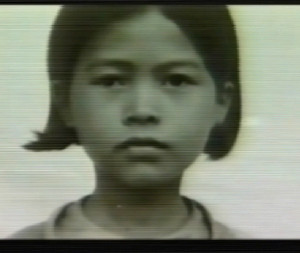 when there were “hundreds of prisoners”. He could not recall the total number of mothers and children. They took shifts to guard, since they were afraid that there were not enough guards. He heard that children were executed behind the prison. [6] The executions sites were to the north and to the west of the prison. At this point, Mr. Koppe interjected and said that the witness had said earlier that he had “no idea” about the execution of children.[7] Mr. Huy now said that Peng had told him about the killing of children. They were separated from their parents, since the children would have cried if they were taken to the execution sites with their parents, and the information “would have been leaked” to garment workers and others on the road. They were between one and six years old.
when there were “hundreds of prisoners”. He could not recall the total number of mothers and children. They took shifts to guard, since they were afraid that there were not enough guards. He heard that children were executed behind the prison. [6] The executions sites were to the north and to the west of the prison. At this point, Mr. Koppe interjected and said that the witness had said earlier that he had “no idea” about the execution of children.[7] Mr. Huy now said that Peng had told him about the killing of children. They were separated from their parents, since the children would have cried if they were taken to the execution sites with their parents, and the information “would have been leaked” to garment workers and others on the road. They were between one and six years old.
Mr. Farr showed another video clip. It showed photographs of two children with a voice over of Him Huy saying that mothers were told that their children were taken to a children center, while they were actually killed.[8] Mr. Farr inquired how he knew that the mothers were told this. Mr. Huy answered that Peng told him that the mothers would have learned about “what we were going to do with the children” otherwise.
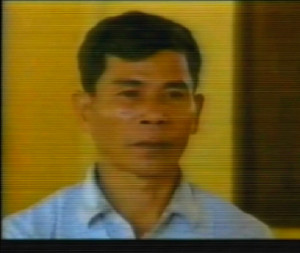
Him Huy in the clip shown by the Prosecution
Mr. Farr showed another clip that showed Him Huy recounting that the children were killed in the same way as adults: blindfolded and with their hands tied behind their back.[9] Mr. Huy recounted that he brought the children downstairs before sending the parents to Choeung Ek, following a list that Suos Thy had given him that listed the parents who were to be sent to Choeung Ek. He was asked to bring down the children to the ground floor and hand them over to Peng. He assumed that killings would have been taken place the same way as for adults. Babies were carried down, but denied having helped this process: the security guards did that and he was responsible for sending the parents to Choeung Ek instead. Confronted with another excerpt of a documentary that showed Van Nath saying that Him Huy carried babies downstairs, he said that this was correct.[10] The children were between one month until seven or eight years old.
Vietnamese soldiers
Turning to his next topic, Mr. Farr inquired about Vietnamese soldiers at S-21. Mr. Huy recounted that Peng’s group was the one who killed the people. There were between forty and sixty Vietnamese soldiers that had been arrested and sent in on different time frames. He went to Svay Rieng on different occasions. There were Vietnamese soldiers from 703 and other directions, but he did not know them all. Reacting to an excerpt of his Written Record of Interview, in which he had said that both Peng’s team and his own team were involved in killing Vietnamese soldiers, he said that his group of guards were told to “send them away”.[11]
Moving to his next line of questioning, Mr. Farr wanted to know whether he knew what happened to Pouch, who had been mentioned yesterday. The witness replied that he was with the 100-Men-Unit and was arrested around 1977. He did not know about the arrests specifically, but noticed that people disappeared around meal time. There were successive arrests. Three or four other people were arrested from the 100-Men-Unit: Smuon and Man, who was Cham, and Chhon, who was also Cham. This happened in the same period, since one person would implicate others.
In his Written Record of Interview, he had said that Duch had told them that those from those from Division 703 who had been implicated by other 703 members had also been arrested and killed on the S-21 compound. At the time, the Choeun Ek execution site had not yet been established.[12] Mr. Huy said that he drew his own conclusion that Pouch had been implicated by others. He did not know who implicated others for the subsequent arrests. Before adjourning the hearing for a break, the President instructed the witness not to speculate.
Bringing prisoners to Choeung Ek
The witness did not know how old the children of the other Huy were when the latter was arrested, and he could not remember their names. He said that the wife might have been called Koeun and Huy’s younger sibling Hoeun was also arrested.
Mr. Farr then read out an excerpt of his Written Record of Interview, in which he had said that killings continued at S-21 for small groups of people or important people, even after the establishment of Choeung Ek.[13] The witness confirmed this: Only high-ranking cadres were killed at S-21. Mr. Farr then inquired whether anyone ever told him why killings were stopped at S-21 and Choeung Ek was established. He replied that “information of the killings may have been leaked to the international”, which was why the location might have been found. To refresh his memory, Mr. Farr referred to the witness confrontations that took place a few days after the site visit at Choeung Ek. Duch had said that the execution site was moved to Choeung Ek, because of the number of corpses and the risk of epidemics.[14] Mr. Huy answered that there was “bad smelling” at S-21, which was why the killing site was moved to Choeung Ek. As for the number of people who were killed at Choeung Ek and S-21 together, the witness asserted that he did not hold the documents, but said that there were tens of thousands people who were killed there. There were more than 20,000, he said. He said that the Chamber could ask Suos Thy about the total number of people who were killed there. Ta Hor would tell the witness when it was time to bring another group of prisoners to Choeung Ek. He would also tell him how many vehicles were needed.
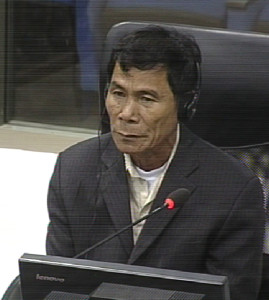
Witness Him Huy
According to an excerpt that Mr. Farr read out, Teng had said that Huy told him two days in advance that prisoners would arrive and that pits needed to be dug. The witness recalled that Hor had told him once that two graves needed to be dug. One grave could fit fifty to one hundred bodies. Sometimes a grave would be used to bury around sixty bodies. One vehicle could accommodate thirty to forty prisoners. Sometimes, they had to go two times with the prisoners on two vehicles. Sometimes he was required to call, sometimes Phal and sometimes Peng. This depended on the instructions of Hor. He could not recall how many times he went to the location and how often Phal “did the job”. He would take prisoners to Choeung Ek at around 8 pm or later. The prisoners’ hands were tied behind their back and they were blindfolded. The regulation was not to tell the prisoners that they would be killed. They would be told that they were required to “live in a new house”. Two guards were on one vehicle – one was the driver and the other one in the cabin. He did not receive the list of prisoners from any other person, but he was given a pen and piece of paper to register the numbers of prisoners he received. He would present this note to Suos Thy to verify the numbers of prisoners sent to Choeung Ek. Suos Thy knew how many prisoners were sent out of Tuol Sleng.
“I would do the headcount when the prisoners were uploaded on the vehicle”.
He would count them again when arriving at Choeung Ek. He would then send the report to Suos Thy to verify the number. Suos Thy would compare the number of prisoners given by Huy with the one that he had in his hand. After handing over the report, Huy went back to his location.
Arrival at Choeung Ek
The witness then proceeded to describe the procedure that took place at Choeung Ek. Upon arrival, the guards would help unloading the prisoners and bring them to the big room in a wooden house. The prisoners were handcuffed and their hands were tied behind their backs. They were blindfolded not to recognize the route they were sent along. There was one generator that was used for when the prisoners were there. The generator “made a loud noise” while running and was located near a tomb. When the prisoners were sent out of the house, prisoners were taken one by one. Huy would sit on a chair near the house and write down the name of each prisoner, after which they would be sent for execution. At the pits, prisoners were asked to sit down and were clubbed on the back of their neck. He would write a sequential number and the names of their names. Ta Hor was the one who organized the executions and have each prisoner walked to the pits. The witness did not know whether the prisoners knew they were about to be killed – they were told that they had to be relocated to a new house. Confronted with an excerpt of Tay Teng’s testimony, in which he had said that prisoners were crying and begging for their lives, Mr. Huy said that he did not hear the prayers, but heard their crying.[15]
Some prisoners wept after their names were written down, as “they knew they would be killed”. After the name was written down, the prisoner was brought to the pit and asked to kneel down. A metal bar was used to hit them, before their throat was slashed. Subsequently, the clothes were stripped off the prisoners and the prisoners were disemboweled. Their handcuffs and blindfolds were removed before they were thrown into the pits.
“It was Hor and Duch who told us how to kill prisoners”.
They told them that they had to struck the prisoner on their neck, slash their throat, remove their clothes and disembowel the prisoners. The same instructions were relayed to them when they were at Choeung Ek. Ta Hor was in the same vehicle as the guards, while Duch was in a separate jeep. Ta Hor “came every time”, whereas Duch rarely visited the site. The witness saw him about three times. They had to guard the fence along the execution site.
Mr. Farr asked whether he was asked on one or several occasions to kill prisoners. Following an interjection and discussion with his duty counsel interjected, Mr. Huy declined to answer the question. Mr. Koppe said that the witness had no right to decline answering the questions for two reasons: First, because of the content of the statements so far. There was only a gradual difference between doing the actual killing and organizing in terms of criminal responsibility. Secondly, he had been convicted by a court after 1979 for his involvement in the killing at Choeung Ek. Thus, there was no risk of double-jeopardy (ne bis in idem) and he had no right to decline to answer on grounds of incriminating himself both factually and legally. Judge Jean Marc Lavergne asked whether Mr. Koppe had references for previous convictions, which Mr. Koppe had not. Judge Claudia Fenz asked whether Mr. Huy was convicted for the exact same acts. to which Mr. Koppe answered that the witness himself had given evidence that he was convicted for the killing at Choeung Ek and general responsibility at S-21. Mr. Koppe gave the reference, which was an article in Searching for the Truth, saying that he was convicted for two years.[16]
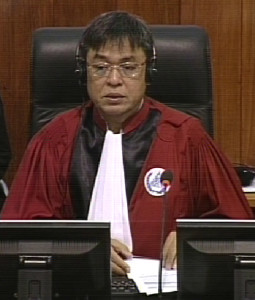
Trial Chamber President Nil Nonn
Judge Fenz asked whether the witness had a written verdict of a judgment. The witness recounted that he was arrested in 1981 and detained two to three months, and then sent to work at rice field at the Vietnamese border. Ten months later the police from the district released him. He did not understand when Judge Fenz asked him about a trial, nor did not know whether he went through a trial. The President informed the parties that the court was only established after 1982. “It was in its full operation in 1984, though I may need to find such a document”. Thus, the President deemed it appropriate that the witness refused to respond to the question due to the risk of self-incrimination.
Mr. Huy did not know when Son Sen became Duch’s superior. He did not know who Duch’s superior was when Son Sen left to the battlefield. He confirmed that Son Sen left on the battlefield to fight the Vietnamese. Mr. Huy had requested to go to the battlefield so that only he would die and not his family members. This took place in around 1977. At this point, the President adjourned the hearing for the lunch break.
Leadership
After the break, Mr. Farr read an excerpt of the witness’s statement, in which he had said that he saw Son Sen for the last time in 1977, after which he did not come back to S-21.[17] He had referred to both Ta Khieu and Son Sen. Mr. Farr asked whether this was the same person, which Mr. Huy confirmed. Son Sen stopped training them in 1977. However, “he was still the superior of Duch”. Duch did not make any announcement that Son Sen was not Duch’s superior anymore. Asked about Brother 1 and Brother 2, Mr. Huy said that Brother 1 was Pol Pot and Brother 2 was Nuon Chea. During the training session, Duch referred to Brother 1 and 2. Mr. Farr quoted Prak Khan’s testimony, in which he had said that Brother 1 and Brother 2 were Duch’s superior.[18] Mr. Huy answered that Duch had mentioned Brother 1 and Brother 2. He did not hear Duch say that Brother 1 and 2 were his superiors. “Perhaps there were meetings of interrogators with Duch and Peng”. All of them went to a training session south to Duch’s house.
Mr. Farr then inquired whether he had ever heard of Office 870 during the time at S-21. Mr. Huy said that he had heard of this office, but did not know where it was. Duch mentioned Office 870, but Mr. Huy did not know why. When Mr. Huy could not give more information on the role of Office 870, Mr. Farr handed the floor to the Civil Party lawyers.
Vehicles
Under questioning of National Civil Party Lead Co-Lawyer Pich Ang, Mr. Huy recounted that he started working at S-21 in 1976. At this time, members of Division 703 “were borrowed” to arrange the location. This location had “many entrances and gates”. The north and west gates were closed and only the gates that he was standing guard at allowed people to pass through. He saw vehicles coming in and out of S-21. These vehicles belonged to S-21. They were the same vehicles as the one from Division 703.
He did not know where the headquarters of Division 310 were. Chinese-made four-wheel trucks were used to transport prisoners. Sometimes the Zone used American trucks. S-21 had five vehicles: two land rovers, one Chinese-made vehicle and two other vehicles. Ten people could be transported in one land rover. The two land rovers went to collect people. One land rover was used by the guards for protection. When vehicles arrived, people were unloaded and the school was closed. The vehicles were in Phnom Penh. Occasionally he went to receive people with Ta Hor, and sometimes other people went with him. They worked as a big group, since there were shortages of staff sometimes.
Rights of prisoners
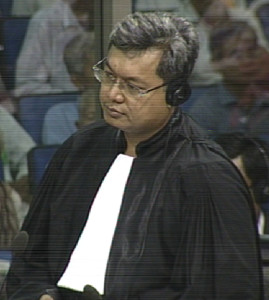
National Civil Party Lead Co-Lawyer Pich Ang
Mr. Ang asked whether anyone told the prisoners about their rights, which the witness denied.
“No one said anything. And while they were in the vehicle, they were told to keep quiet”.
There was a strict rule “that we should not do anything to the prisoners during the transportation”. They had to be transported safely to be interrogated at S-21. No prisoner asked for water or food on the way from where they were arrested to S-21.
Moving to his next topic, Mr. Ang wanted to know how often vehicles were used to transport prisoners from S-21 to Choeung Ek. The witness replied that it happened rather frequently.
“Prisoners did not have any rights, since they were considered enemy, so their rights forfeited”.
Moreover, “anyone who was arrested was considered an enemy, so they did not have any right”. They would be “in trouble” if they gave rights to the prisoners. Ta Hor taught them, including the witness, karate. However, he was hit in his mouth once, so he stopped doing that. Ta Hor told them that they had to attend the training to prepare the arrest of prisoners so that they could not fight back or protest.
Executions
Mr. Ang wanted to know whether there was an instance where the parents had been taken to Choeung Ek first and the children killed later, which the witness denied. Children had to be taken first, since children would make noise in the building if their mother was gone. Mr. Ang asked why it was necessary to disembowel the prisoners after they had been struck. He replied that they would be disemboweled to prevent swelling and that the stench would “get out”.
He would write down their names next to a light bulb. It was “rather far” from the house. The list of names from S-21 was with Thy. He asked him to write the names down again to verify the names. Upon the arrival at Tuol Sleng, he gave the list to Suos Thy.
Mr. Ang then asked him to describe the feelings or regrets he might have about S-21. He replied that
While I was working at S-21 … I was afraid that sooner or later I would be arrested and killed. In 1975 when Phnom Penh was liberated, there was an instance where a colonel was released and later on I was brought to work at S-21, and I was rather afraid of my previous activities. For that reason, I made a request to Son Sen to return to the army so that if I was in trouble, only myself would die and not the rest of my family members.
I actually also had another plan to convince other people to rebel, but it was leaked and Ta Duch was aware of that, and during a study session Duch asked me that Morn actually said that I actually had a plan to rebel, but I said that ‘no, that was nonsense. It was nothing like that.’ But in fact, three days previously, Hor who had a key to the weapon warehouse, I actually entered the weapon warehouse to see what weapons were stored there. Ta Duch was concerned about that, and he asked his drivers to move those weapons to the General Staff office. Later on, I was sent to work at the rice field at Choeung Ek and later on I was gathered to the forest. And later on, I actually gathered some of my close friends, about 20 of us, with some weapons, and we fled away from his group.
The President said that it was not appropriate to ask about the harm and feelings of the witnesses, since these questions should be put to Civil Parties and not witnesses. At this point, Mr. Ang finished his line of questioning and handed the floor to his international colleague.
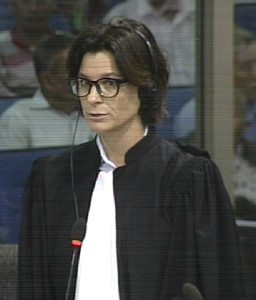
International Civil Party Lead Co-Lawyer Marie Guiraud
International Civil Party Lead Co-Lawyer Marie Guiraud asked whether the Vietnamese people he collected at Svay Rieng were all military or also civilians. He replied that he did not know who were soldiers and civilians, but they were told that they had to arrest five soldiers. They wore uniforms with the military caps.
Ms. Guiraud said that Prak Khan and Lach Mean had talked about the arrival of Vietnamese prisoners.[19] Mr. Huy confirmed having shown a film about their arrival and said that some of them did not have any rank. The film was a summary of their interrogation and execution. He could not recall well whether there were also other prisoners in the film.
There was a young guard who raped a female prisoner. That young guard had committed “moral offense” with the female prisoner. He was “arrested, detained and killed” later. He did not recognize that guard, since he was working inside the compound under the supervision of Peng, nor did he know other incidences besides this incident. A staff member at S-21 was arrested and detained. The victim of the rape was also arrested and killed. One guard fled to Vietnam and returned to Kandal Province. He is deceased by now. Since Ms. Guiraud ran out of time, she finished her line of questioning, after which the President adjourned the hearing for a break.
Follow-up questions by Judge Jean-Marc Lavergne
After the break, Ms. Guiraud said that there had been a translation error and asked the witness to repeat the name. He replied that his name was Chhoy. He fled the prison, reached Vietnam and returned from Vietnam in 1979. He never met him. The floor was granted to Judge Jean-Marc Lavergne.
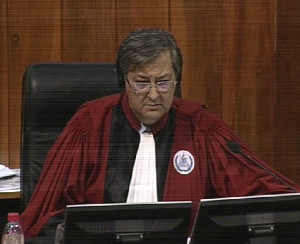
Judge Jean-Marc Lavergne
Judge Lavergne wanted to know whether he remembered what methods were used in the film about the Vietnamese prisoners. Mr. Huy confirmed that these Vietnamese soldiers were tortured and he saw blood stains on their bodies. Moreover, he saw the prisoners that were to be interrogated when he went to see Thy; he saw wounds on their backs. However, he did not know the details about their interrogations, since he had no authority to be there. In the film, he could see that they were ordered to walk in a file, executed, and disemboweled. A person called En was in the group who filmed it. The film included all processes: interrogations and executions. When the film was screened, “everyone was there”. There was no sound to the film to his recollection. He saw “important people” on the film. Ta Pong’s photo was in the film, as well as the one of Hu Nim. He was not sure which position Ta Pong held. It had been said that he held a logistic position in the general staff section. He did not personally see the prisoners being beaten. The film did not show prisoners confess. He could not recall the date, but said that it was “during the study session” on 17 April of that year. The film was screened inside the wall along the road. The people who watched it were interrogators, Prey Sar workers, and the staff of S-21, numbering to a total of hundreds of people watching this film. Son Sen was not present, but Ta Duch and Ta were.
At this time, there were two western prisoners. “People said that they were Americans”. They were executed on the road to the north of the compound. They were killed at a junction there. After they were killed, there was an instruction to bury them. However, Ta Duch ordered Ta Hor not to bury the bodies of foreigners and said that their bodies had to be burned, since “foreigners had some gas from their dead bodies”.
The youngest guard was about 15 years old. People who got married at married included around six couples. Women were brought in from the garment section to marry S-21 staff. The ceremony included coconut juice and chicken. On that day, Duch asked him whether he wanted to have a wife, and he replied “what for?”. He thought that there might be a problem for him if he was married. The couples did not know each other before. Duch arranged the marriages. Two couples survived: Phon and his wife and Hor and his wife. He did not know any other detention places except S-21 in Phnom Penh. He had not heard of a detention facility near Wat Phnom. There were no prisoners who managed to escape.
Asked whether he had been a messenger at some point, he recounted that Duch’s messenger asked him a Khraol Kor to bring him to Son Sen’s place, which was to the north of Svay Rieng Province; he went with him to deliver the message to Son Sen.
They were instructed to attend training sessions close to the Olympic Stadium, during which there were also other participants than S-21 staff members, but all soldiers. He did not know about the existence of other security centers. Nor did he know where the other participants were from. Son Sen had talked about the “inner enemies” during the study sessions. They further mentioned the Revolutionary Youth Magazine and the Revolutionary Magazine. Mr. Huy denied having been a member of the CPK. They included Hor and Huoy, “and not others”. Chhaing and Phal were also a member of the party, but they were arrested.
They had gruel at S-21 in the beginning. Later on, some people were sent to Prey Sar for the agricultural production. They were provided with cooked rice later on. Only carpenters and mechanics had cooked rice. Staff members had different rations. For example, the group Mr. Huy belonged to had less to eat than the interrogators. The prisoners inside the cells had only watery gruel to eat. With this, Judge Lavergne finished his line of questioning.
Imprisonment after 1979
The floor was handed to the Nuon Chea Defense Team. An article by DC-Cam said that some former cadres had been sent to prison and had been re-educated: Suos Thy had been imprisoned for four years and Mr. Huy for two years in Kandal Province. [20] Mr. Koppe inquired whether he had been re-educated. He replied that he had to carry water, transport harvest, and transplant rice. He did not protest against any form of labor after the regime. There were no self-criticism meetings, but they were told not to flee and they were told to work. He confirmed that he was imprisoned in Kandal Province. He carried dirt and soil. Mr. Koppe wanted to know whether there were any conditions put on him before his release. He replied that he was told not to engage in such conduct again and encouraged to try to provide food for his family members.
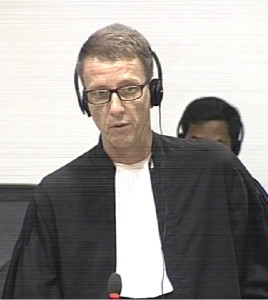
International Nuon Chea Defense Counsel Victor Koppe
When Mr. Koppe wanted to know whether he had been told that Suos Thy had been detained in a high-security prison, Mr. Ang objected and said that the questions were not within the scope of the trial. Mr. Koppe explained that the purpose of the questions were two-fold: first, it went to questions of reliability. He wanted to know whether the authorities from at the time had urged him to say certain things about S-21. Second, Mr. Koppe wanted to know whether he had the right to non-incrimination. Judge Fenz told him that he would not ask for more time, because other more relevant questions had not been asked in time. Mr. Koppe addressed her directly:
“Thank you for your sarcasm again Judge Fenz”.
The objection was overruled.
Mr. Huy said that “each of us was trying to make a living for our wives and children”, which was why he was not in communication with other people.
Moving on in his line of questioning, Mr. Koppe turned back to Mr. Huy’s time at S-21. Mr. Huy recounted that he was removed to work in the field in mid-1978. After 1979, he left the area and went to “where the heavy weapons were stored”. He went to Prey Sar and Choeung Ek afterwards. He had been told that the weapons had been removed and placed into the warehouse of the general staff. It was said that Chhit was “very stubborn”. He asked to refashion Chhit, because he felt pity with him. He said that it w as “thanks to Hor” that Mr. Huy was not arrested at the time.[21]
Nhob Nhun was the former messenger of a cadre. After the cadre had been arrested, he was also sent to S-21. He first worked as a guard. Later, Nhun was arrested and he was sent to work at the field. The other Huy was first arrested and then Hor. The witness was arrested together with other members of 703.
The President adjourned the hearing. It will continue tomorrow, April 5, 2016, at 9 am with the testimony of Him Huy.
[1] E3/7461, at 11:29.
[2] E3/536R, 27:05-27:22.
[3] E3/1693, at 00192723 (EN), 00357310 (FR), 00191879 (KH).
[4] E3/7462, at 11:38.
[5] E3/5154, at 00161603 (EN), 00146651 (KH), 00148099 (FR).
[6] E3/5154, at 00161603 (EN), 00146651 (KH), 00148099 (FR).
[7] E1/50, at 11:47.
[8] E3/2357R, at 40:48-41:15.
[9] E3/536R, at 27:38-28:15.
[10] E3/536R, at 28:45-29:15.
[11] E3/5155, at 00161591 (EN), 00146639 (KH), 00148084 (FR).
[12] E3/5158, at 00164451 (EN), 00164454 (FR), 00164447 (KH).
[13] E3/5155, at 00161592 (EN), 00146640 (KH), 00148085 (FR).
[14] E3/5766, at 00165437 (EN), 00165428 (KH), 00165445 (FR).
[15] April 21, 2016, Testimony of Tay Teng.
[16] E3/1918, DC-Cam, Searching for the Truth.
[17] E3/5155 00161591 (EN), 00146638 (KH), 00148083 (FR).
[18] April 27, 2016, 10:57.
[19] 27 April 2016, at 15:59.
[20] E3/9195, at 00104911 (EN), 00340092 (KH).
[21] E3/7462,a t 14:48.
Featured Image: Witness Him Huy (ECCC: Flickr).

[…] also “Prisoners did not have any rights”, Witness Him Huy Says, The Cambodia Tribunal Monitor, May 4, […]